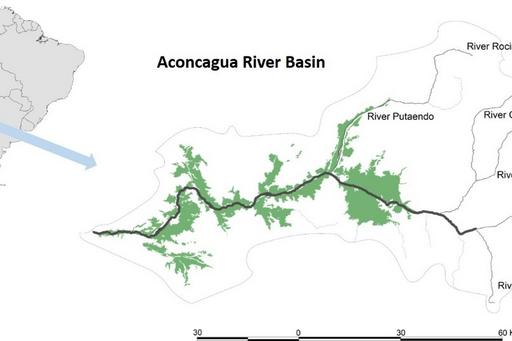
FRAM Case Study: Aconcagua River in Chile - the polluted drinking water supplier
Short description
The Aconcagua River is about 142 kilometers long and runs through five Chilean provinces, supporting a number of cities along its way. Agriculture, mining, and chemical production are the most important economic activities in the area. About 30% of Chilean grapes and peaches, as well as a good part of Chilean avocado are produced in the Aconcagua river basin. These activities inevitably result in pollution by heavy metals and pesticides, but also micropollutants from households and wastewater treatment plants are emitted into the river.
Since the 1960s, Chilean agriculture has experienced rapid, increasingly diversified, export-led economic growth. The growth of the agricultural sector is evidenced by the increase in agricultural GDP of 2.7% between 1963 and 1982, to 5.6%, between 1983 and 2007, making it one of the pillars of the national export structure.
This "boom" of Chilean agriculture caused a progressive growth of imports of pesticides, which rose by 48% in the decade of the 90s, with figures that reached 16,072 tons in 1997 and 17,942 tons in 1998. This increase in pesticide use occurred in an unregulated environment of free sale and easy access by the population, accompanied by a lack of knowledge about the effects of pesticide use on human health and the environment.
The focus of the social science part of the Chilean case study has been to investigate the regulation of pesticides in Chile: high concentrations of pesticides in agricultural products and surface waters point out to a need to reduce their use and the negative effects on human health and the environment. The objective is to identify the reasons behind the high rates of pesticide use and strategies to improve the effectiveness of current regulations.

First field study
In September-October 2018 we implemented our first field campaign in Chile, which was run along the Aconcagua river. The river contains one of Chile’s largest agricultural areas, with major vineyards and vegetable farming, hence an area with extensive pesticide use. Additionally, the area is one of Chile’s biggest copper-mining regions and a major petrochemical installation can be found at the river mouth. In summary, the river hosts a broad range of industrial activities that are all well known to emit toxic chemicals into the surrounding environment.
Result: Insecticides impact the biodiversity in the river
The chemical load at the sampling sites was analyzed using high-resolution mass spectrometry, coupled to an LC and GC system. 679 chemicals were included in the LC-based analysis, of which we actually found 138 chemicals at one or more of the Chilean sites (4 biocides, 31 industrial chemicals, 45 pharmaceuticals and personal care products, 57 pesticides).
The GC based analysis is still ongoing, we expect another 100+ legacy chemicals (PCBs, chlorinated pesticides, dioxins, etc.) to be found with this method. These data are currently combined with information on the ecotoxicity of the detected chemicals, in order to gain a first overview of whether the ecosystem is at risk.
DNA samples were collected at all sites, which were analyzed (sequencing, metabarcoding) in close collaboration with our Chinese partners, in order to get an understanding of the biodiversity impacts of chemical pollution. For the same purpose, we also collected invertebrate samples.
We can clearly show that especially the use of insecticides has a clear impact on the biodiversity in the exposed parts of the river, while other chemicals (e.g. pharmaceuticals and personal care products) seem to be of minor concern for the communities analysed.
Second field study
Based on the results, we are currently setting up the next sampling campaign (to be implemented in autumn 2020), which will in particular extend the scope of the considered chemical pollutants by including metal pollution from mining activities.